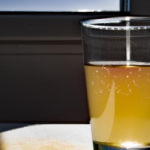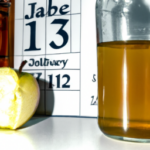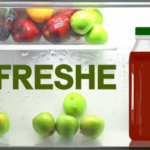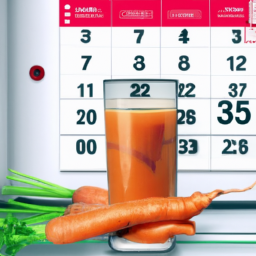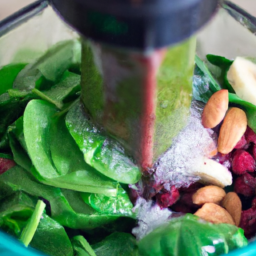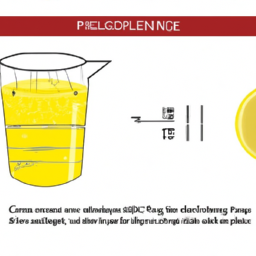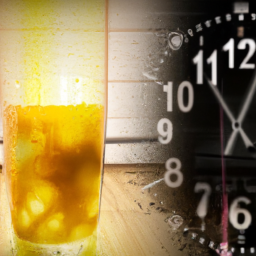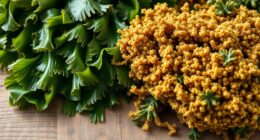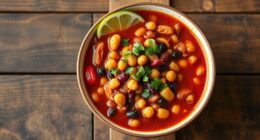As a big fan of apple juice, I often find myself wondering about how long this beverage can last in the refrigerator. This is a common question that requires a precise and detailed answer. After all, nobody wants to drink juice that has spoiled.
In this article, I will delve into the shelf life of apple juice, both unopened and opened, to help you determine when it’s time to toss that bottle in the trash.
First, it’s important to understand what factors affect the shelf life of apple juice. The main factor is whether the juice is pasteurized or unpasteurized. Pasteurized juice has been heated to kill any harmful bacteria and extend its shelf life, while unpasteurized juice is raw and can spoil much faster.
Additionally, proper storage can greatly impact how long apple juice lasts. By understanding the shelf life of apple juice and how to properly store it, you can ensure that your juice stays fresh and safe to drink.
Key Takeaways
- Apple juice lasts 7-10 days in the fridge at 40°F or below, but proper storage impacts shelf life.
- Once opened, apple juice should be consumed within 7-10 days or frozen in an airtight container for up to 8 months.
- Adding ascorbic acid or lemon juice can preserve apple juice for a few more days.
- Spoilage can be detected through smelling, color changes, mold growth, or taste changes, and drinking spoiled juice poses health risks.
Understanding the Shelf Life of Apple Juice
Want to know how long your apple juice will last in the fridge? Let’s dive into understanding its shelf life!
Apple juice has a shelf life of approximately 7-10 days when stored in the fridge at a temperature of 40°F or below. However, this can vary based on the processing method, preservatives used, and storage conditions.
To extend the shelf life of apple juice, there are ways to preserve it. One way is to freeze the apple juice in an airtight container, where it can last up to 8 months. Another way is to add ascorbic acid or lemon juice to the juice before storing it in the fridge, which can help preserve the juice for a few more days.
Apart from its refreshing taste, apple juice also has several health benefits, including being rich in antioxidants and vitamins. To reap these benefits, it’s recommended to consume the juice within its shelf life.
Now, moving on to the subsequent section about unopened apple juice shelf life, it’s important to note that unopened apple juice has a longer shelf life compared to opened juice.
Unopened Apple Juice Shelf Life
As a food scientist, I’ve tested the shelf life of unopened apple juice. I found that it typically lasts for about 6-12 months when stored in a cool, dry place. However, it’s important to keep an eye out for signs of spoilage. These signs include a sour or off smell, cloudy appearance, or mold growth.
To extend the shelf life of unopened apple juice, it’s important to store it properly and avoid exposing it to sunlight or high temperatures.
Average Shelf Life
You may think that your apple juice will last forever in the fridge, but unfortunately, even with refrigeration, its average shelf life is only about a week. This is because apple juice is a perishable item that can easily spoil if not stored properly. Here are some ways to preserve your apple juice and reap the benefits of freshness:
- Store your apple juice in a clean, airtight container to prevent exposure to outside elements.
- Keep your apple juice in the fridge at a temperature between 33°F and 40°F to slow down the growth of bacteria and other microorganisms.
- Avoid exposing your apple juice to direct sunlight or heat, which can cause it to spoil faster.
- Consume your apple juice within 7 days of opening to ensure maximum freshness.
By following these guidelines, you can extend the shelf life of your apple juice and enjoy its delicious taste and nutritional benefits for a longer period of time. However, if you notice any signs of spoilage, such as a strange odor or taste, mold growth, or discoloration, it’s best to discard the juice immediately.
In the next section, we’ll discuss the signs of spoilage in more detail.
Signs of Spoilage
To determine if your apple juice has spoiled, take note of any changes in its color, smell, or taste. Common contaminants like bacteria and mold can grow in apple juice over time, especially if it’s not properly stored in a sealed container in the refrigerator.
If your apple juice appears cloudy or has a strange odor, it may have started to spoil. Similarly, if the taste has a sour or vinegar-like flavor, it’s best to discard the juice. Drinking spoiled apple juice can pose potential health risks, including upset stomach, diarrhea, and food poisoning.
While it may be tempting to try to salvage the juice by removing any visible mold, it’s better to err on the side of caution and throw it away. To prevent spoilage of apple juice, it’s important to keep it refrigerated at all times and consume it within its recommended shelf life.
In order to extend the shelf life of apple juice, there are a few tips you can follow. Keep the juice in a sealed container and refrigerate it immediately after opening. Avoid leaving it out at room temperature for extended periods of time. Additionally, consider freezing the juice in small portions if you don’t plan on consuming it all within a few days.
By following these simple steps, you can enjoy your apple juice for longer and reduce the risk of spoilage.
Tips for Extending Shelf Life
If you want your refreshing apple juice to remain fresh and delicious for longer, there are some tips you can follow to extend its shelf life.
First and foremost, make sure to store your apple juice in the fridge at all times. This will help slow down the growth of bacteria and keep your juice fresh for longer.
Additionally, make sure to keep your apple juice sealed tightly when not in use. This will prevent air from getting in and causing oxidation, which can lead to spoilage.
Another great way to extend the shelf life of your apple juice is to get creative with recipes. Adding apple juice to smoothies, cocktails, and even marinades can help use up your juice before it goes bad.
Additionally, you can try DIY preservation methods such as freezing your apple juice in ice cube trays or canning it. These methods can help you keep your apple juice fresh for months or even years!
As for opened apple juice shelf life, it’s important to note that once you’ve opened your apple juice, it will generally only last for 7-10 days in the fridge. However, by following the tips mentioned above, you can help extend the shelf life of your apple juice and enjoy its delicious flavor for longer.
Opened Apple Juice Shelf Life
When you open a bottle of apple juice, it will typically last for about 7-10 days in the fridge. This shelf life can vary depending on factors such as the temperature of the fridge and the presence of preservatives in the juice. It’s important to check the expiration date on the bottle as well as the color and odor of the juice before consuming it. If the juice has a strange odor or color, it’s best to discard it.
If you find yourself with leftover apple juice that you can’t consume before it expires, there are several ways to use it up. You can use it as a base for a smoothie or cocktail, add it to oatmeal or pancake batter, or even use it as a marinade for meat.
Consumption of apple juice has been linked to several health benefits, such as improved digestion, increased hydration, and potential reduction in the risk of chronic diseases.
When it comes to apple juice, it’s important to consider whether the juice is pasteurized or unpasteurized. Pasteurized apple juice has been heated to a high temperature to kill any potentially harmful bacteria, whereas unpasteurized apple juice has not undergone this process. The decision to consume pasteurized or unpasteurized apple juice should be based on personal preference and any potential health concerns.
Pasteurized vs. Unpasteurized Apple Juice
Pasteurized and unpasteurized apple juice have distinct differences in taste, but they also vary in terms of juice safety and health benefits.
Pasteurization, the process of heating juice to a high temperature to kill harmful bacteria, prolongs the shelf life of apple juice. However, this process also eliminates some of the natural enzymes and nutrients present in raw juice.
Unpasteurized apple juice, on the other hand, retains these enzymes and nutrients, making it a healthier option. However, unpasteurized juice can also contain harmful bacteria, like E. coli and Salmonella, which can lead to serious illnesses, especially in young children, older adults, and individuals with weakened immune systems.
Despite the potential health risks, many people prefer unpasteurized apple juice for its rich and complex flavor profile. It’s important to note that both pasteurized and unpasteurized apple juice can provide health benefits like antioxidants, vitamins, and minerals.
However, it’s crucial to handle and store apple juice properly to ensure juice safety and maintain its quality.
Properly Storing Apple Juice
To keep your apple juice fresh and full of flavor, it’s essential to store it properly. Here are a few tips to ensure that your apple juice stays fresh for as long as possible:
-
Keep it in the fridge: Apple juice should always be stored in the fridge to maintain its freshness and prevent oxidation. Room temperature will cause the juice to spoil quickly.
-
Use an airtight container: To prevent air from getting inside the container and causing oxidation, use an airtight container to store your apple juice. This will help to preserve the flavor and extend its shelf life.
-
Keep it away from light: Light can cause the juice to break down and spoil faster. Keep your apple juice in a dark place or in a container that blocks out light.
-
Don’t leave it open: Leaving your apple juice open can cause the juice to oxidize quickly, which will result in a loss of flavor and freshness.
By following these simple steps, you can keep your apple juice fresh and delicious for up to a few weeks. However, it’s important to check for spoilage before drinking it.
Checking for Spoilage
Make sure you check your apple juice for any signs of spoilage before drinking it, because nothing ruins your day like a glass of funky-tasting juice. There are a few ways to tell if your apple juice has gone bad, including using the smelling test and checking for any color changes.
The smelling test involves taking a whiff of the juice to see if there are any off odors. If the juice smells sour or musty, it’s likely that it has begun to spoil. Additionally, if you notice any changes in the color of the juice, such as it turning brown or cloudy, it’s best to avoid drinking it. Mold growth or taste changes are also indications that the juice has gone bad. It’s important to note that even if the juice appears and smells fine, it may still be unsafe to drink if it has been stored improperly or for too long.
Moving forward to the next section about freezing apple juice, it’s important to know the proper way to do so in order to maintain the quality of the juice.
Freezing Apple Juice
When it comes to preserving apple juice, freezing is a popular option. There are both pros and cons to freezing apple juice. The extended shelf life is a pro, but there is potential loss of flavor and nutrients.
The freezing process involves carefully transferring the juice to a freezer-safe container and ensuring it’s properly sealed. Thawing and using the frozen juice requires some planning ahead.
Pros and Cons
Interestingly enough, the pros and cons of storing apple juice in the fridge for extended periods vary greatly.
On the one hand, refrigeration can help preserve the nutritional benefits of the juice, such as vitamins and minerals. Additionally, cold temperatures can slow down the oxidation process and prevent spoilage. However, there are also some downsides to storing apple juice in the fridge for too long.
Here are some pros and cons to keep in mind:
- Pros: Refrigeration can extend the shelf life of apple juice, preserve its nutritional value, and keep it fresh for longer.
- Cons: Storing apple juice in the fridge for too long can result in flavor variations, as the juice may start to taste sour or stale. Additionally, over time, the juice may lose some of its nutritional benefits.
Moving on to the freezing process, there are some important factors to consider.
Freezing Process
To freeze your apple juice and keep it fresh, I recommend using the blanching method. This involves boiling the juice for a short period of time, usually around 30 seconds, then rapidly cooling it down in an ice bath. This process helps to preserve the flavor and nutrients of the juice, while also preventing any bacteria from growing.
Once blanched, transfer the juice to an airtight container, leaving about an inch of space at the top for expansion during freezing. Another option for freezing apple juice is to use ice cube trays. Pour the juice into the trays and freeze until solid. Once frozen, transfer the cubes to a freezer-safe container or bag. This method is great for portion control, as you can easily grab a few cubes to use in smoothies or other recipes. However, it may not be the best option for large quantities of juice.
When it comes time to use your frozen apple juice, there are a few different methods for thawing. Stay tuned to learn about the best ways to thaw and use your frozen juice.
Thawing and Using Frozen Juice
As we saw in the previous subtopic, freezing apple juice can be a great way to extend its shelf life. However, once you’re ready to use the frozen juice, it’s important to follow the proper thawing process to ensure optimal flavor and quality.
The thawing process for apple juice is relatively simple. You can either leave it in the refrigerator overnight to thaw slowly or place the container in a bowl of cold water to thaw more quickly. It’s important to avoid thawing the juice in warm water or in the microwave, as this can lead to flavor changes and potentially even spoilage. Once the juice is thawed, be sure to give it a good shake or stir before using to redistribute any settling that may have occurred during freezing.
To help illustrate the potential flavor changes that can occur during freezing and thawing, take a look at the table below. It shows the results of a taste test comparing fresh apple juice to juice that had been frozen and thawed using different methods. As you can see, the flavor of the frozen and thawed juice can vary depending on the method used, with some methods leading to a more pronounced loss of flavor than others.
| Thawing Method | Flavor Rating |
|---|---|
| Refrigerator overnight | 4/5 |
| Cold water bath | 3/5 |
| Warm water bath | 2/5 |
| Microwave | 1/5 |
| Fresh juice | 5/5 |
As you can see, the best method for thawing apple juice is to do it slowly in the refrigerator. This will help to preserve the flavor and quality of the juice as much as possible. Now that we’ve covered the thawing process, let’s move on to some tips for buying apple juice.
Tips for Buying Apple Juice
When you’re shopping for apple juice, it’s important to look for a brand that uses only 100% pure juice. Choosing brands that use pure juice ensures that you get the best nutritional value from your purchase. Some brands may include additives or preservatives that can diminish the quality of the juice.
Make sure to read the label carefully before purchasing to ensure that you’re getting the best quality juice. In addition to choosing a brand that uses pure juice, it’s also important to consider the type of apple used. Different types of apples have different flavors and nutritional values, so it’s worth researching which type of apple is used in the juice you’re considering.
By taking these factors into account, you can ensure that you get the best quality and nutritional value from your apple juice. Now that you’ve chosen the perfect apple juice for your needs, let’s explore some recipes for using up any excess juice you may have.
Recipes for Using Up Apple Juice
Hey, you’ve got some leftover apple juice and you’re wondering what to do with it? Let me tell you, that sweet nectar can be a secret ingredient in your kitchen, like a hidden gem waiting to be discovered in a treasure chest.
Here are some recipes for using up that leftover apple juice:
-
Apple juice cocktails: Apple juice is a great mixer in cocktails, adding a sweet and fruity flavor. Try mixing it with vodka and ginger beer for a refreshing Moscow Mule, or add it to bourbon and lemon juice for a twist on a classic Whiskey Sour.
-
Baking with apple juice: Apple juice can be used in baking to add moisture and flavor. Try substituting it for half of the liquid in muffin or cake recipes, or use it to make a glaze for bread or pastries.
-
Apple juice marinade: Apple juice can be used as a base for a marinade for meats, adding a sweet and tangy flavor. Mix it with soy sauce, garlic, and ginger for a delicious marinade for chicken or pork.
-
Apple juice popsicles: Mix apple juice with a bit of honey and freeze it in popsicle molds for a refreshing summer treat. You can also add in slices of fresh fruit or herbs for added flavor.
So, don’t let that leftover apple juice go to waste! Use it to add some sweetness and flavor to your favorite recipes.
Frequently Asked Questions
How can I tell if apple juice has gone bad?
I can determine if apple juice has gone bad by examining the signs of spoilage. These include a sour smell, mold growth, and a cloudy appearance. Apple juice has shelf stability for up to one year if unopened and stored properly.
Can I mix expired apple juice with fresh apple juice?
I do not recommend mixing expired apple juice with fresh apple juice. Storage recommendations suggest discarding expired juice for safety reasons. It is best to check the expiration date and consume or discard accordingly.
Is it safe to drink apple juice that has been left out overnight?
It is not safe to drink apple juice that has been left out overnight due to the potential growth of harmful bacteria. Room temperature can accelerate this process. To ensure safe consumption, store apple juice in the fridge and consume within its expiration date.
Can I store apple juice in the freezer for longer shelf life?
Freezing apple juice concentrate can extend its shelf life indefinitely. Utilizing creative recipes like adding it to smoothies or cocktails is a great way to reap the benefits of drinking apple juice regularly.
Does the expiration date on apple juice refer to the unopened or opened bottle?
The expiration date on apple juice refers to the unopened bottle. Once opened, the juice must be stored in the fridge and consumed within 7-10 days for optimal shelf stability. Proper storage methods can prevent spoilage and extend the juice’s freshness.
Conclusion
In conclusion, understanding how long apple juice can last in the fridge is essential for ensuring that you’re consuming safe and fresh juice.
The shelf life of unopened apple juice is much longer than opened apple juice, and pasteurized apple juice lasts longer than unpasteurized juice. Proper storage is also crucial, and checking for signs of spoilage is necessary before consuming.
And if you have excess apple juice, freezing is an option for extending its shelf life.
Overall, buying apple juice can be a tasty and nutritious addition to your diet, but it’s important to be informed about the shelf life and storage methods to avoid consuming spoiled or expired juice. So, don’t let your apple juice go to waste, and use it up in delicious recipes like apple cider vinegar or apple jelly.
Trust me, with these tips, you’ll be able to enjoy your apple juice for a long time to come – maybe even until the end of time (okay, maybe not that long, but you get my point).
Ilana has been a vegan for over 10 years. She originally made the switch for health reasons, but soon found herself becoming more and more passionate about the ethical and environmental implications of a vegan lifestyle. Ilana is the author of The Graceful Kitchen, a blog all about veganism. She loves to cook up delicious and nutritious vegan meals, and share her recipes with others who are interested in leading a cruelty-free life. Ilana is also a strong advocate for using whole foods as the foundation of a healthy diet, and believes that going vegan is one of the best ways to achieve this.



